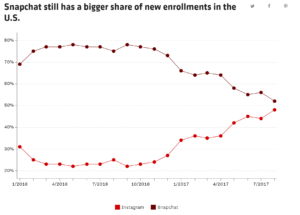Instagram: Social Media’s Big Winner

The ‘Gram’s rise to dominance.
Introduction
In a time of social media platform proliferation, Instagram’s growth has been astounding. Instagram is adding 100M monthly active users every four months, as well as 1M advertisers every four months. Users are increasing video consumption 80% year over year, and users are producing ~four times as much video content. The average user who is 25 and under spends over 30 minutes a day scrolling through their newsfeed, and soon Instagram will boast more monthly user signups than Snapchat, the social media IPO darling of yesteryear. These statistics beg the question: how has Instagram managed to dominate the social media landscape?
Figure 1: New User Acquisition for Instagram
Creating Value for Users
From inception, Instagram has delivered a unique social media experience for users via product innovation. The platform was the first to introduce photo filters that enhance special moments in our daily lives. This form of sharing still serves as Instagram’s foundation today; no social media platform is better at enabling users to share special moments. Instagram has expanded on this success by offering users multiple avenues for sharing moments, and those avenues trump the competition. For example, “stories” let users share more spontaneous moments from their day to day lives, and include video editing features such as Boomerang or Rewind, as well as creative interactive features such as face filters (sorry Snapchat) and polling. Additionally, Instagram recently introduced galleries, allowing users to upload multiple photos from an event such as a wedding, vacation, etc. These avenues for sharing, coupled with Instagram’s social graph (thanks, Facebook) which allows users to quickly and easily find new friends, creates a unique social media experience for users.
Creating Value for Advertisers
Instagram has also created tremendous value for businesses and advertisers through influencer marketing. As previously mentioned, advertisers are flocking to the platform. More astoundingly, over 70% of Instagram users engage with and / or follow a business. A few key components of Instagram’s operating model have enabled this traction. Firstly, Instagram ensures that sponsor ads blend in very naturally to the Instagram newsfeed, and so users do not find them intrusive or off-putting (think of the popup video ad that never goes away in your internet browser). Additionally and perhaps most importantly, Instagram constantly encourages collaboration between influencers and businesses. For example, brands like Covergirl are enlisting multiple Instagram influencers with large follower bases to showcase and model their products; the experience feels more authentic and personal for target demographics. Businesses are reaping the benefits: studies have shown that for every $1 of influencer media spend on Instagram, the return for brands can be up to $7 in earned media. More authentic brand engagement also enhances user satisfaction and attracts more people to the platform, enabling the growth cycle to continue.
Conclusion
Clearly, Instagram has done an excellent job creating commercial success through key operating model and product decisions; this success has been so prominent, though, that developed societies like the U.S. are beginning to worry about broader societal impact. Instagram has come under the microscope of far-reaching media outlets like TIME (see: “Why Instagram is the Worst Social Media for Mental Health”), as researchers are uncovering the dark side of social media. The same features that inspire users to scroll through their Instagram newsfeed for over 30 minutes a day potentially result in unrealistic expectations of self, anxiety, and depression. These revelations are prompting increased investment in solutions such as the “attention economy”, which consist of apps and tools to help users spend less time on their smartphones. How will Instagram respond? How will history view Instagram’s success? The jury is still out, but Instagram’s success and far-reaching impact is undeniable.
References
Etherington, Darrell. 2018. “Instagram Now Has 800 Million Monthly And 500 Million Daily Active Users”. Techcrunch. https://techcrunch.com/2017/09/25/instagram-now-has-800-million-monthly-and-500-million-daily-active-users/.
“Instagram Is Rapidly Eating Away At Snapchat’S Share Of New Users”. 2018. Recode. https://www.recode.net/2017/9/19/16308788/snapchat-instagram-sign-ups-new-users-us-global.
“Instagram Wants You To Know People Spend More Time With Instagram Than Snapchat”. 2018. Recode. https://www.recode.net/2017/8/2/16081086/instagram-snapchat-stories-anniversary-time-spent.
Liu • Contributor, Lesya. 2018. “Instagram Continues Its Mind-Blowing Rise”. Entrepreneur. https://www.entrepreneur.com/article/294949.
“The Rise Of Instagram And Influencer Marketing”. 2018. The Yale Tribune. https://campuspress.yale.edu/tribune/the-rise-of-instagram-and-influencer-marketing/.




Interesting thoughts. Outside of the broader societal impact that Instagram has (which is a huge issue in its own right), what type of regulations do you think they are going to be subject to. I also wonder how Instagram manages to maintain its edge or coolness factor in the dynamic social media environment. It seems like Facebook’s time as a growing channel was only about 5 years, and Snapchat is decelerating. How does Instagram settle in as a social media powerhouse once its insane user growth starts to slow down? Will it become more integrated into the FB platform?